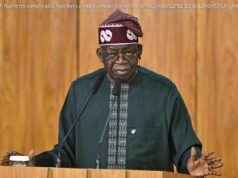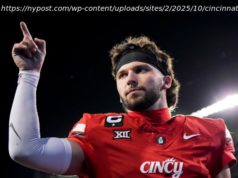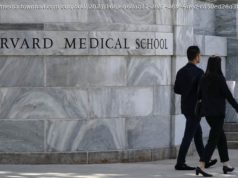Was the joint statement complete? What’s happening about sanctions? And how long will this new bromance last?
They came, they met, they signed.
But what exactly did the world’s two most unpredictable leaders, Donald Trump and Kim Jong-un, agree to at their historic summit?
For a start, they declared that the United State and North Korea, which have technically been at war for almost seven decades, are about to “establish new US-DPRK relations”. But here are four key questions from the landmark summit:
Will ending war games deepen fears among US allies?
Donald Trump vowed to end his country’s war games with South Korea in the new era of ties with the North.
“Under the circumstances that we’re negotiating a very comprehensive complete deal, I think it’s inappropriate to have war games… It is something that [North Korea] very much appreciated,” Trump said at the press conference after the nearly four-hour summit.
He also said his country is “prepared to start a new history” with North Korea. Trump called the annual war games “very provocative”, a term Pyongyang often uses to describe what it sees as rehearsals for an invasion.
The North has long thought of US troops in the South as a threat to its security and almost pulled out of the summit because of naval drills between US and South Korean forces in May.
For his part, Trump has publicly complained about the cost of keeping a base in South Korea, saying he would like to reduce the number of troops unless Seoul shares the cost.
“The war games are very expensive; we paid for a big majority of them, we fly in bombers from Guam,” Trump said. He has made similar complaints about Japan.
It is unclear whether Trump consulted South Korea or Japan before making the announcement about ending the war games or how their security will be affected.
Was the joint statement missing some important words?
The statement Trump and Kim signed reaffirmed the declaration Kim signed with South Korean President Moon Jae-in in, but failed to set out specific measures for denuclearisation or include the term complete, verifiable, irreversible denuclearisation (CVID) on the Korean peninsula, which has been a key US demand.
The statement only said “reaffirming the April 27,2018 Panmunjom Declaration, the DPRK commits to work toward complete denuclearisation”.
Analysts said the summit was only a political success as it failed to include details or a time frame.
“What the world wanted to see was… the denuclearisation process and the security guarantee. [But] there was neither timeline nor details,” said Kim Sung-chull, a professor at the Institute for Peace and Unification Studies at Seoul National University.
Su Hao, a professor at the China Foreign Affairs University, said CVID is a long process: “This is just the very first meeting to talk on a principle frame… So this would be in the follow up talks on the working level such and maybe on a next summit.”
How will the US verify that denuclearisation takes place? Trump said there will be many more meetings and there was not enough time to go through these issues.
Can the summit in Singapore end months of animosity?
After more than a year spent hurling insults at each other, Trump and Kim spent the summit shaking hands, smiling and going on a short stroll which ended with the US president showing the North Korean leader his specially equipped bulletproof vehicle nicknamed The Beast. Kim expressed his “gratitude” to Trump at the summit. Trump also told reporters that the summit was an “honour” and hailed Kim as a “very talented man who loves his country very much”. They had formed a “special bond”, he said later.
Watch: the trailer Trump showed Kim
Has a blossoming bromance replaced talk of fire and brimstone?
Despite the praise, Trump played down suggestions he and Kim were bosom buddies.
“No I don’t think that – I don’t view it that way,” Trump replied. “He is very talented, I did not say he is nice.”
Kim’s body language also suggested that the two leaders had established a warm rapport by the end of the meeting.
When Kim first met Trump he did not maintain eye contact too often, partly because of Korean etiquette and partly out of nervousness, body language experts said. Yet hours later, when they emerged from their talks, Kim appeared more relaxed and comfortable, smiling naturally.
The question on the minds of many analysts is will this be a lasting bond?
Sanctions will probably continue but could they be eased?
While Trump replied with a firm “no” when asked whether economic sanctions imposed on North Korea since last year would be lifted, China seems to have softened its stance on the issue. Russia has also called for them to be scrapped.
Since last August, the United Nations Security Council slapped sanctions on North Korea that could see the country’s US$3 billion annual export revenue drop by a third – banning exports of coal, iron, iron ore, lead, lead ore and seafood. They were meant to punish Pyongyang for testing two missiles.
“Adjustment to the sanctions has to be made in accordance with the situation on how North Korea has implemented the agreement – including suspending or removing relevant sanctions measures,” China’s foreign ministry spokesman Geng Shuang said at a briefing in Beijing before Trump’s press conference. “The actions taken by the UN Security Council should support the current diplomatic dialogues and efforts in progressing towards denuclearisation of the Korean peninsula.”
Wang Sheng, a professor of Korean affairs at Jilin University in northeastern China, said Beijing’s sanctions will probably remain in force as long as Washington’s are.
“China and the US are still very coherent on their stance on sanctions,” Wang said. “Unless North Korea takes more concrete step towards achieving complete denuclearisation, China is likely to remain firm on sanctions.”






